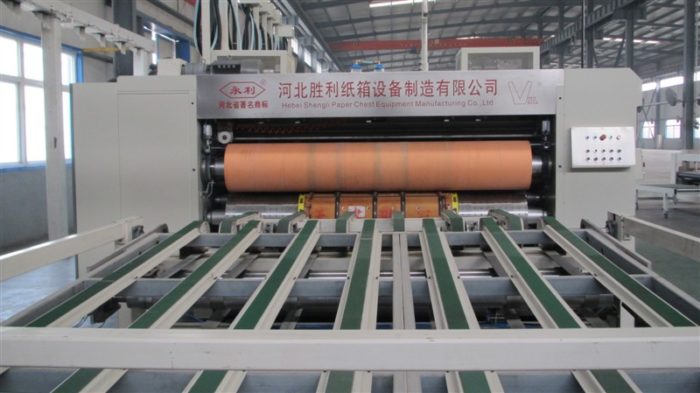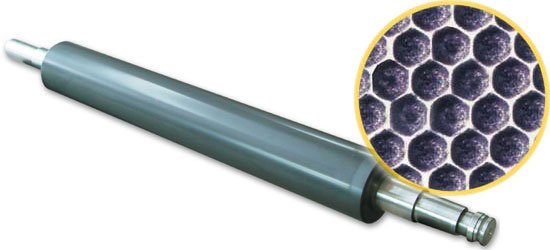Blog >> Flexo Printing Process of Corrugated Carton & Box

automatic flexo printing and die cutting machine for corrugated box
Corrugated box Flexo post-sheet printing is the most common process in which the combined corrugated board is printed directly. It is typically used in the flexo-folder-gluer which is a corrugated box-making machine. The machine has the capability of one-pass multi-color flexographic printing, scoring, slotting, die-cutting, folding and gluing the manufacturer’s joint. Corrugated blanks that have been scored in the cross flute direction in the “sheet plant” are loaded on the feeding side of the machine. A printed, folded and joint glued box comes out on the delivery side of the machine.

Figure 1 Flexographic Printing Process
As shown in Figure 1, the print station is the housing unit for impression cylinder, plate cylinder, anilox roller and ink fountain. A flexo-folder-gluer can have any number of print stations for a multi-color printing job but most new machines have three to five color capabilities. The main parts of a print station are:
2.1.1 Ink Supply System
The ink supply system applies ink to the printing plate. Water based inks are used in this process which have a tendency of drying quickly, so a continuous supply of ink is maintained to the anilox roller. Ink is supplied in pails which act as a reservoir of the ink. A pump assembly is used to transfer ink from the pail to the ink pan. The ink pan holds a small quantity of a continuous supply of ink. A part of anilox roller submersed in the ink pan and picks up the ink from there.
A doctor blade wipes off the extra ink picked by the anilox roller and makes an even layer of ink on the anilox roller.
Controlling the viscosity of the ink is very critical for the printing process. Naturally, ink viscosity increases during normal operation. The cost of printing can go up if high viscosity inks are used on the press. Water is added to balance the viscosity of the ink. Water caused the ink pH to go down, so a proper mixture of water and amines are used to adjust the ink viscosity and pH.
2.1.2 Anilox Roller

The anilox roller is the most important part in the inking system. It controls the ink metering process and supplies an even film thickness to the plate cylinder. It is made of steel and is chrome plated or ceramic coated to improve the life and performance of the roll. For more stiffness and lighter weight, carbon fiber anilox rolls are also used. These rollers are about 40%-60% lighter in weight compared to conventional steel rollers (Perkins 2000, Schnell 2000).
Anilox rollers have tiny engraved cells on its entire surface along the length of the roll. These cells are so small that generally they cannot be seen with the naked eye and even cannot be felt by sliding one’s hand on the surface of the roll. These tiny cells carry ink from the ink pan to the plate cylinder.In order to change the color on an ink station or to halt the machine for a longer period of time, the ink station has to be cleaned. Water based inks has the tendency to dry very quickly on the anilox roller. Dried ink is hard to clean and increases the set-up and change-over time. After every run of the machine, immediately, a flexo cleaner is circulated through the inking system. The cleaner is a mixture of mild detergent and warm water having a temperature range of 100 – 140 ◦F.
2.1.3 Printing Plate and Cylinder
The printing cylinder is made of steel and holds the rubber printing plate. It serves as a host to the printing plate to facilitate the ink transfer from the printing plate to the substrate.
Printing plates are made of rubber or photopolymer. Rubber plates are made by curing natural or synthetic rubber in a mold. Whereas commonly used photopolymers plates are made up of a light sensitive material. The image is developed by exposing the plate to ultra violet light through a photographic negative. When light hits the photopolymer plate, the image area is hardened and the non-image areas remain soft and dissolve out in a developing solution. The image areas remain in the relief form and hence only image areas accept the ink and transfer it to the substrate.
Another method of making a flexo printing plate is by laser engraving. A computer controlled laser engraves the image on the plate. These plates offer unmatched quality comparable to the gravure printing process but because of its high cost of production, they are not common in use.
Once the printing plate is ready, it is mounted on the printing cylinder using different mechanism depending on the machine manufacturer. One common method involves using double sided tapes to mount printing plate to the printing cylinder. Once the printing station is ready, operator adjusts the slotting and scoring section of the machine. In order for the box to get its shape, the box blank has to be scored in both vertical and horizontal directions. Flexo-folder-gluer is designed to score only in one direction. Scoring in other direction is done at corrugated blank manufacturing plant. Hence, flexo-folder-gluer receives blanks already scored in one direction.
In the slotter scorer section of the machine, blank is scored to create four body panels of the box, slotted to create top and bottom flaps and create the manufacturer joint to join the box to the fourth panel. Set up of the slotter/scorer section can me manual, semi-automatic and fully automatic. Multiple male and female scoring heads are mounted on two shafts of the flexo-folder gluer machine in the slotting/scoring section. As the blank passes through these shafts, the scoring head creates a crease or score on the blank. The profile of scoring head and the pressure between the male and female scoring heads defines the quality of the score. Immediately after scoring, blank passes through another pair of shafts loaded with male and female slotting heads. These heads trim the outside edges of the blank; create top and bottom flaps and a manufacturer joint.
After all the printing, scoring and slotting action, blank enters into the folder gluer section. In this section, blank is folded to fasten manufacturer joint to box using glue application. Folding of the blank is done by adjustable folding rods and belts with steel rails. Adhesive is applied to secure manufacturer joint to the box. Adhesive application is either done by nozzles or a wheel glue applicator. At this point, the corrugated box is ready in a knock down position. The box moves further to the delivery section where multiple knocked down boxes are stacked up and strapped together to ship to the warehouse.
2.1.4 Impression Cylinder
The substrate is pressed between the impression and printing cylinder. The impression cylinder provides counter-pressure to the printing cylinder necessary to transfer ink from the printing plate to the substrate. It is also made up of steel and rotates at the same speed as the printing cylinder.
2.2 Flexo pre-print
In the flexo pre-print process, the top liner of the corrugated board is printed before the board is combined on the corrugator machine. The flexo pre-print process uses the same printing technology as post-sheet process i.e. flexographic printing.
In the pre-print process, flexographic printing yields better print quality than the post-sheet printing method. However, the print quality for both processes is not as high as the lithography process (Barnes 2011). Since the pre-print process provides a smoother surface for printing, the quality is better but lower than lithography due to lower screen resolution. This printing process has a resolution of 120-133 lpi (Eldred 2008).
Quality is also better than post-printing because of the use of white-top linerboard which has one side white and other side brown. The white surface reflects more colors than brown kraft and helps to produce more vivid colors with better quality.
The process requires a very high volume of print order to make the process economical. For an independent corrugator, one truck load of preprinted paper rolls is required to justify the plates cost and other cost drivers (Barnes 2011). This process has a very large initial capital investment for the machinery. The machinery includes a high speed multi-color flexography printing machine. The machine can cost as much as a corrugator machine. Hence printing and corrugation is done mainly by integrated convertors rather than independent.
For pre-print, the flexographic printing press can be wide web or narrow web. Wide web presses are of generally 110” to 130” wide and narrow web presses are 30” to 60” wide. These presses are capable of printing 4 or more colors.
Like post-print, printing plate is a big cost factor in flexo-pre-print. Pre-print plates can cost somewhere from 5000 to 25,000 USD for four colors depending upon the size of the machine. Set up time and cost is also huge. Hence, a high volume is required to justify the total cost of the process in order to make boxes cost effectively.
The flexo pre-print is an indirect process where post-sheet is a direct process. In pre-print, the web is printed first and then it serves as a feed stock for the corrugator machine as a top liner where it is combined into corrugated board. The printed stock is mounted in the corrugating machine as the top linerboard, and two other webs of unprinted stock are also mounted serving the medium and the bottom linerboard for the corrugated box. In the delivery station, a printed combined corrugated blank is received as the output. The blank is then further processed either in a flexo-folder-gluer or in a specialized piece of equipment which serves the slotting, scoring, die-cutting, folding and gluing functions. Cutting dies is also a big cost factor in this process.

SinoCorrugated Exhibiton is the biggest and most important exhibiton for corrugated carton flexo pri...

In 1989s, China begin reform and opening, there exist mostly state-owned factories before that. Aft...

Corrugated Box Making Machine and ProcessAs used herein and as well understood in the industry, corr...

What are the types of corrugated boxes which are used in industries?The factors that are considered ...

Corrugated boxes are made from corrugated paper which is glued to the flat facing of a flat paper ma...